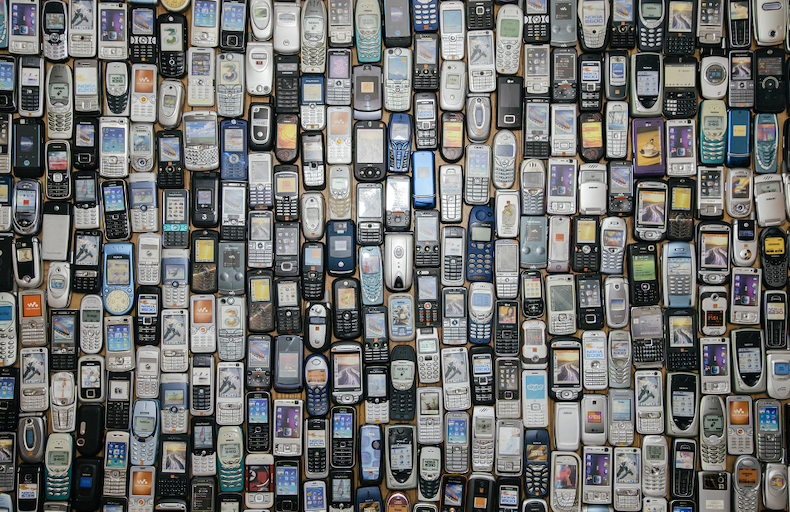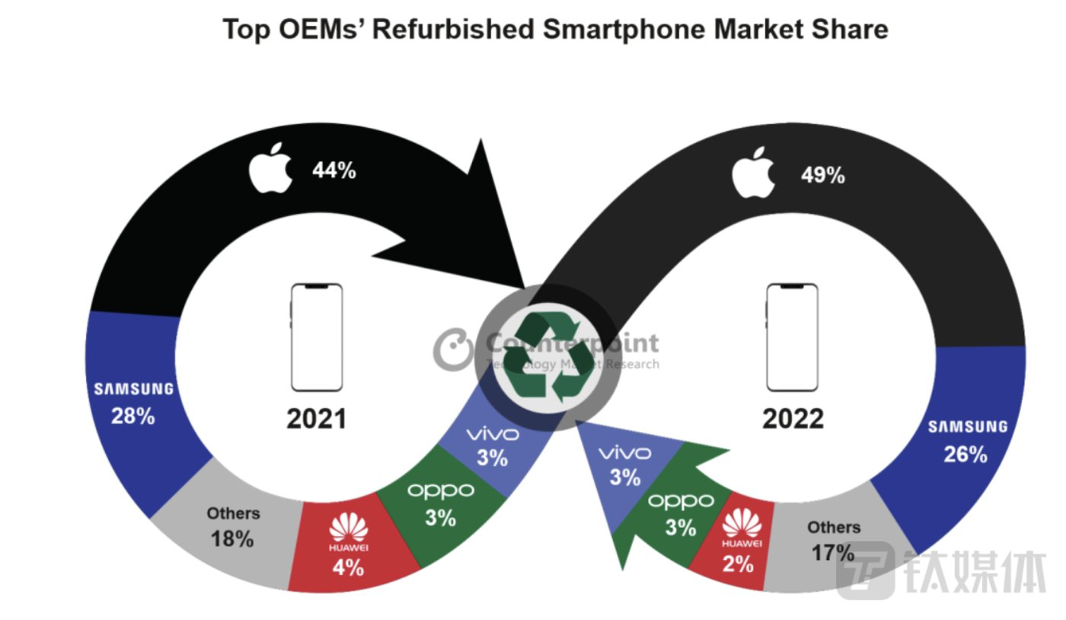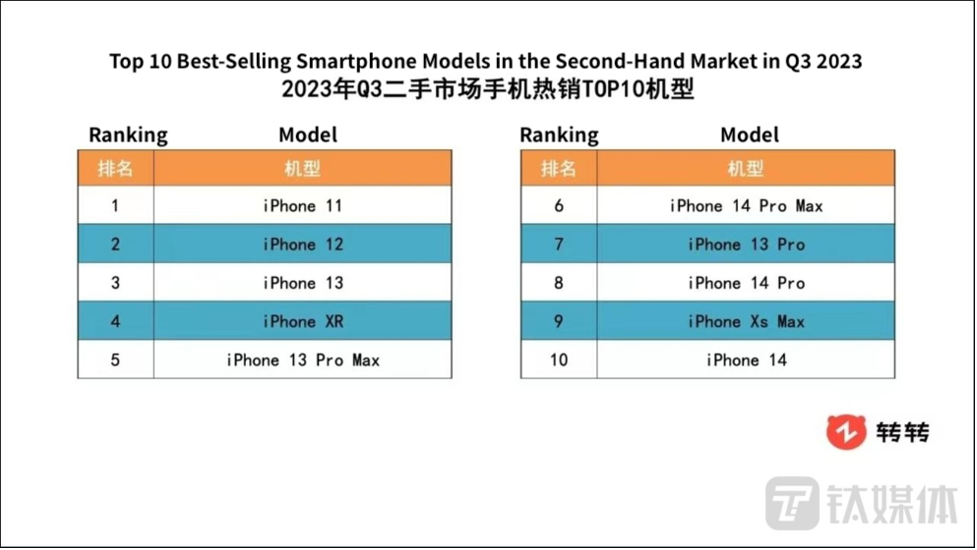
Source: Visual China
By Du Zhiqiang and Shaw Wan
BEIJING, November 7 (TMTPOST) — Lai Qiang, a 24-year-old entrepreneur based in southwest China’s Chengdu, has been running a telecommunications and digital business for the past four years. In addition to repairing smartphones, he also engages in the buying and selling of well-maintained used devices. Despite having a shop with an area of less than ten square meters, Lai managed to earn an average monthly income of over ten thousand yuan (about US$1,370) this year. Even during the off-season, Lai’s income rivaled what he made during peak seasons last year. Lai attributed such success to the now favorable second-hand smartphone market.
However, businesses like Lai’s, which exclusively dealt with well-maintained used devices, were not among the most profitable. “Those who refurbish smartphones, especially those who refurbish them to look and function like brand new devices and have sales channels, earn even more. It only takes them a few months to make enough money to buy a one-bedroom apartment in Chengdu,” Lai told TMTPost.
The refurbished smartphones are a type of used phones. By buying the original ones at a lower cost and replacing some damaged parts to achieve performance and appearance similar to new or premium-grade devices, merchants manage to secure a higher profit margin. According to Lai, his former mentor, who used to specialize in refurbishing iPhones, could earn over two hundred thousand yuan a month. After refurbishment, even heavily damaged devices that initially costed only a few hundred yuan could be sold as brand new devices.
“To be honest, we despise these refurbished phone vendors. Prices have been driven down by them. And even if we sell our devices at reasonable prices, they can still make a killing because their costs are much lower,” Lai said. “But things have improved lately. Some daredevils are still out there, while most now sell their refurbished phones as well-maintained devices with major cosmetic refurbishments and minimal internal repairs,” he added.
In 2022, the global shipment volume of used smartphones, including officially refurbished devices, reached 282.6 million units, with 11.5 percent year-on-year growth, according to data from the International Data Corporation (IDC). The number was expected to reach 413.3 million by 2026, with a compound annual growth rate (CAGR) of 10.3 percent from 2021 to 2026.
Refurbished smartphones bought from official platforms and reputable third-party sellers pose minimal issues. However, the second-hand market is chaotic. Most refurbished devices are heavily damaged smartphones assembled by profit-driven merchants with replaced non-certified components. They not only jeopardize the quality but also lead to a phenomenon where subpar products drive out the good ones.
Refurbished phone sales rise, new device sales fall
Smartphones have reached a plateau in terms of performance and technology. Consumers tended to make more rational choices when upgrading their current devices. Thus, second-hand smartphones became more appealing.
Compared to new devices, second-hand smartphones have larger room for growth in terms of inventory, prices, and distribution channels. The overall costs and market pressures are also lower. And their cost-effective nature helped grab a portion of the demand that would have otherwise gone to new devices.
The demand for smartphones remained, although the new devices were different from the used ones in the product forms and consumer patterns, a person familiar with the smartphone industry chain told TMTPost. The decline in the sales of new smartphones does not imply that smartphones won't circulate in the secondary market.
However, in comparison to new devices, the second-hand smartphone market has its own set of rules and categories, such as well-maintained devices and refurbished ones. When dealing with well-maintained devices, platforms like Aihuishou, a bidding-based company for recycling and selling used electronic items, provided only basic cleaning and packaging before reselling them, according to Qiu Jiawen, head of the Added-Value Business Department of ATRenew, the parent company of Aihuishou. As for refurbished devices, certain components needed to be replaced before being put back on the market.
The global demand for refurbished smartphones is on a steady rise. According to Counterpoint Research’s Global Refurb Smartphone Tracker, the global second-hand smartphone market saw a year-on-year increase of 5 percent in 2022, as the demand for refurbished smartphones continued to grow in most regions.
According to Lai, refurbished phones have become a more popular choice for consumers, as prices of new smartphone got higher. This is especially true in smaller cities and towns in fourth and fifth-tier regions, when spending two or three thousand yuan to buy an iPhone adds prestige and status. Moreover, with the rise of short video platforms, many content creators prefer using second-hand iPhones for shooting videos. “They say it's for better video quality, but I guess it boils down to the brand. I have a friend who specializes in refurbishing iPhones, and his business has been booming for the past a few years. He always informs customers about which parts have been replaced. Those customers, however, as long as they see that the quality is fine, don't really seem to mind,” Lai said.
The global sales of refurbished smartphones last year were less than 20 percent of new smartphone sales during the same period, according to TechInsights, an information platform for the semiconductor industry. The number climbed to nearly 25 percent this year. Price is the primary concern for refurbished smartphone consumers. A well-maintained refurbished iPhone typically costs two-thirds of the price of a brand-new iPhone of the same model, while refurbished Android smartphones often come with even larger discounts.
“Different consumers have different purchasing abilities, and most would prioritize the cost-effective ones. Refurbished smartphones offer consumers a more diverse range of choices," said Qiu. “Based on our financial reports, the total revenue from sales of refurbished smartphones exceeded 190 million yuan in Q2, accounting for 7.2 percent of self-operated product sales revenue and showing a 4.5 percent year-on-year increase. While the overall proportion is not very high, this business is in the early stages of capacity expansion and has significant room for improvement," Qiu added.
In terms of the buyer demographics, people in southeast China’s Guangdong province tended to prefer refurbished phones, with no significant differences observed in other regions, according to Aihuishou. An operator from an e-commerce platform also pointed out that in terms of sending and receiving locations, cities in Guangdong province, such as Shenzhen, Dongguan, and Huizhou, were seen more often.
In 2022, the global refurbished smartphone market had sales of approximately 250 million units. While this was considerably smaller than the 1.2 billion units in the new smartphone market, it has become a significant segment in the smartphone industry.
Standards for refurbished smartphone business
As non-standard products , used smartphones, especially the refurbished ones, their prices vary based on appearance, functionality and sources.
In terms of sources, refurbished phones can be divided into official ones and third-party ones. The former are smartphones that have been reclaimed, refurbished, and re-offered for sale by the official brand or manufacturer. An employee from some smartphone brand said that official refurbished devices came from genuine brand products, with most of them originating from fully functional products returned under a 7-day, no-questions-asked return policy. If any components were damaged, they were returned to the factory for standardized refurbishment, in an environment similar to that of assembling new devices.
Official refurbished devices also came with original components and were covered by the brand's official warranty, just like new devices. “The main differences are in the labeling on the device itself and the packaging. The appearance may show signs of use, but it still undergoes testing to meet the 99% new standard before being released to the market,” explained the employee. For instance, Samsung's 7D official refurbished devices might have “7D” laser-engraved on the back of the main device. Consumers could also find a label with detailed product information on the packaging box.
 Source: Samsung Flagship Store
Source: Samsung Flagship Store
Apart from Samsung, companies like Huawei and Apple have all ventured into the refurbished smartphone business, offering prices that are roughly 20 percent lower than those of new devices. Huawei, for instance, has introduced certified second-hand devices and official refurbished devices. However, the former were currently out of stock, while official refurbished devices included models like the Huawei Mate Xs2, P50 Pocket, and nova9.
As for third-party refurbished devices, most people believed it only involved the replacement of damaged components and, therefore, would be cheaper. However, that’s not entirely true.
There are three rules regulating this industry. Firstly, the source of refurbished old devices must be legal and cannot involve stolen or robbed phones. Businesses or platforms have an obligation to inspect and authenticate the sources.
Secondly, not all components can be refurbished and replaced, and using original components also requires official authorization. Qiu told TMTPost that Aihuishou's refurbishment business focused only on the replacement of screens and batteries. The replacement components were sourced from third parties that have their independent brands and trademarks. They also must meet national certification standards as well as third-party brand requirements and quality standards.
“At present, we do not perform any refurbishment or replacement operations on components like the rear cover and motherboard, certain functional issues, the software, and so on. This is because using original components can trigger intellectual property issues. For example, the brand logo on the back cover. If it is changed without proper authorization, there could be a risk of IP infringement,” Qiu said.
Thirdly, businesses or platforms should provide after-sales service for refurbished devices, typically for one year. Furthermore, they are required to inform consumers about which components have been replaced; otherwise, they could be accused of deceiving consumers. “The rules are good. But for many offline small vendors, they won't disclose this information unless you ask. As for warranties, providing three months of coverage is already considered good,” Lai said.
It's precisely because of the various requirements for refurbished devices that compliant businesses and platforms tend to be strict when collecting them. Qiu said that, compared to regular second-hand devices, the entry threshold for the refurbishment business was much higher. “For starter, there needs to be a high demand for refurbished devices to ensure efficient turnover. The devices also need to be in good condition. For instance, the rear cover is crucial for pricing,” Qiu added.
iPhones, the hard currency
Due to the stringent requirements and considerations related to turnover rates and profits in the refurbished smartphone market, iPhones have become the hard currency, the brand that is not likely to depreciate suddenly or to fluctuate greatly in value.
A wholesaler with five years of experience in the second-hand industry told TMTPost that used phone buyers prioritized value for money, especially for high-end brand products. When it came to refurbishing, there were higher expectations for brands. “I mostly deal with iPhones, and occasionally, I’ll buy back new models from Huawei and Xiaomi. Beyond profits, what's more important is the ability to quickly turn around inventory,” the wholesaler said.

Source: Counterpoint
Apple took up over 49 percent of the second-hand smartphone market, making itself the fastest-growing brand in the global refurbished smartphone industry, according to Counterpoint, a global technology market research firm. In comparison to the shipment volumes of new smartphones in major markets, Apple was the primary contributor to the growing market share of refurbished smartphones. Supply constraints were particularly evident in the refurbished iPhone market.
According to the 2021-2022 Phone Depreciation Rate Report published by the market statistics firm BankMyCell, the average depreciation rate for iPhones after four years was 20.5 percent, while for Android devices, it was 34.44 percent. However, in the first year, there was a significant gap between the two, with iPhones depreciating at 13.83 percent and Android devices at 32.06 percent.

Source: Zhuanzhuan
Based on the rankings in various categories, iPhones continued to be the darling in the second-hand smartphone market, according to the Q3 Mobile Market Report released by Zhuanzhuan, an online platform where users buy and sell used goods. They once again secured the top positions in three major lists —the list of search volume, total transaction volume, and the devices people are looking to sell or recycle.
“Apple releases new iPhone models once a year. Prices of iPhones tend to remain relatively stable for most of the year, apart from significant price fluctuations for older iPhone models right before the launch of new ones. This stability helps maintain market balance. Thus, we don't have concerns about being too aggressive in acquiring older iPhone models,” said the wholesaler.
There was a substantial supply of older iPhone models in China, resulting in a significant storage capacity. Wholesalers tended to perform differentiated refurbishment, targeting different consumer groups. “Despite the powerful Internet with its transparent information, people's preferences are complex. There's a market for every grade of refurbished device. Some businesses even specialize in exporting refurbished devices to markets like Dubai, Africa, and India, where older iPhone models are especially popular,” said a seller in Huaqiangbei, a subdistrict in south east China’s Shenzhen and home to one of the largest electronics markets in China.
“Like China's Huaqiangbei several years ago, Dubai is probably the largest second-hand smartphone market in the Middle East. And many Chinese have opened stores there. Older iPhone models are quite popular. For the Apple products alone, the daily throughput can reach over a hundred thousand units. Moreover, their selling prices tend to double those China,” Lai said.
According to Counterpoint, in 2022, India led the global refurbished smartphone market, experiencing year-on-year growth of 19 percent. Latin America closely followed with an 18 percent year-on-year increase.
Profit-seeking is where It begins
For the new smartphone market, the major players were brand manufacturers like Apple, Huawei, and Xiaomi. However, the refurbished smartphone market involved competition among thousands of individual stores, platforms, and brands. Unlike brand manufacturers, the store owners often lacked substantial capital and long-term strategic planning. Their primary goal was to quickly resell more smartphones and earn higher profit margins with minimal capital investment.
After talking with multiple used smartphone dealers, TMTPost learned that, in most cases, the profit margin for used smartphones fell within the range of 100 to 500 yuan. For devices in equivalent condition, refurbished smartphones tended to yield slightly higher profits, with a margin difference of around 200 yuan. And they also had a higher turnover rate. That was why platforms like Aihuishou and many businesses ramped up investment in this sector. There was also a special category for the devices with broken screens and shattered backplates — the “war-damaged”. For some daring businesses, particularly those involved in refurbishing devices categorized as “war-damaged,” their profits could reach ten times higher.
“The profit depends on how daring you are. Contrary to the profit logic of new devices, the better the condition, the lower the profit margin. Selling three or four devices in their original condition with equivalent grades may yield the same profit as one refurbished device. To earn higher returns, many businesses refurbish damaged high-end devices into excellent condition. Some even go as far as refurbishing them to look like brand new devices,” Lai said.
However, according to Lai, some cunning businesses tried to outsmart the consumers by diverting attention or downplaying certain issues when selling refurbished devices. For example, they might inform consumers about screen or back cover replacements to shift their focus away from potential problems with the device's mainboard or other critical components. “If consumers are concerned about the condition of a refurbished device, they can consider spending a small amount, such as 30 or 50 yuan, to have the device inspected at another shop. If the seller has been hiding any issues, they may become apprehensive at this point. However, it's essential to remember the old saying — You get what you pay for. No business operates without seeking profit, so the price and quality often go hand in hand,” Lai said.
TechInsights' latest research predicted that in 2023, global sales of refurbished smartphones would increase by 17 percent year-on-year to nearly 300 million units for the full year. This number was expected to grow rapidly, approaching 500 million units by 2028. “Unregulated development will eventually encounter bottlenecks. Only through compliant and orderly refurbishment can this industry truly expand,” Qiu said.
(Note: US$1 equals 7.28 yuan.)



